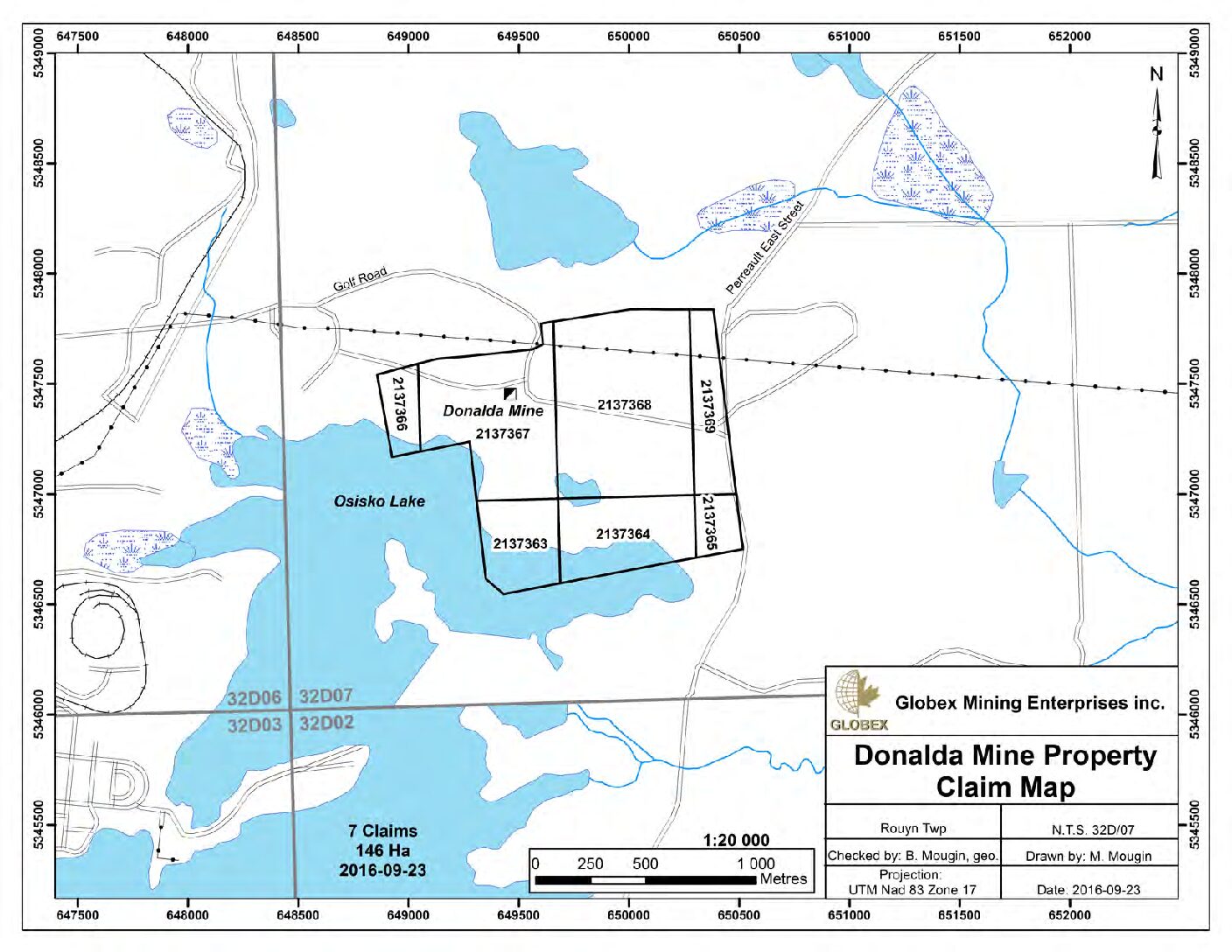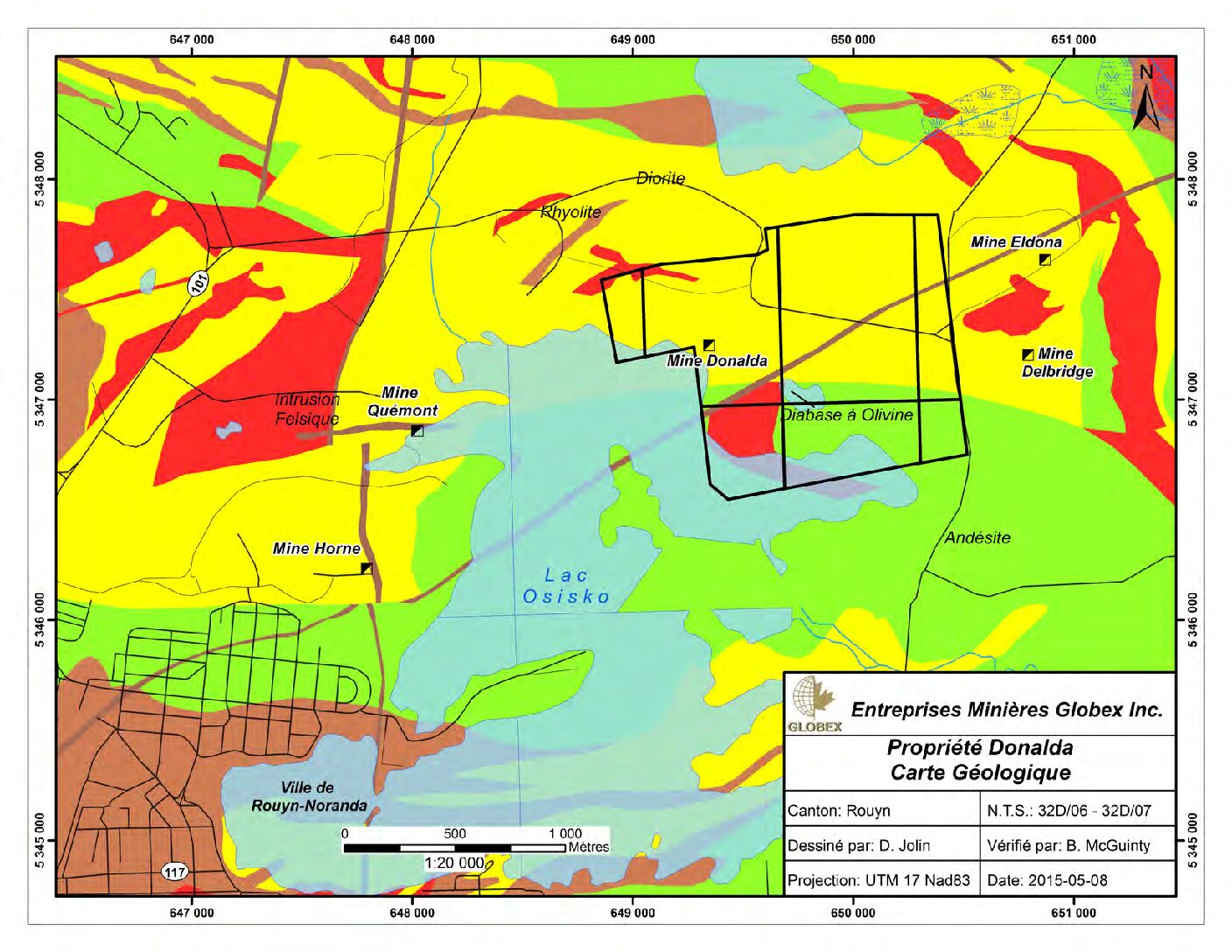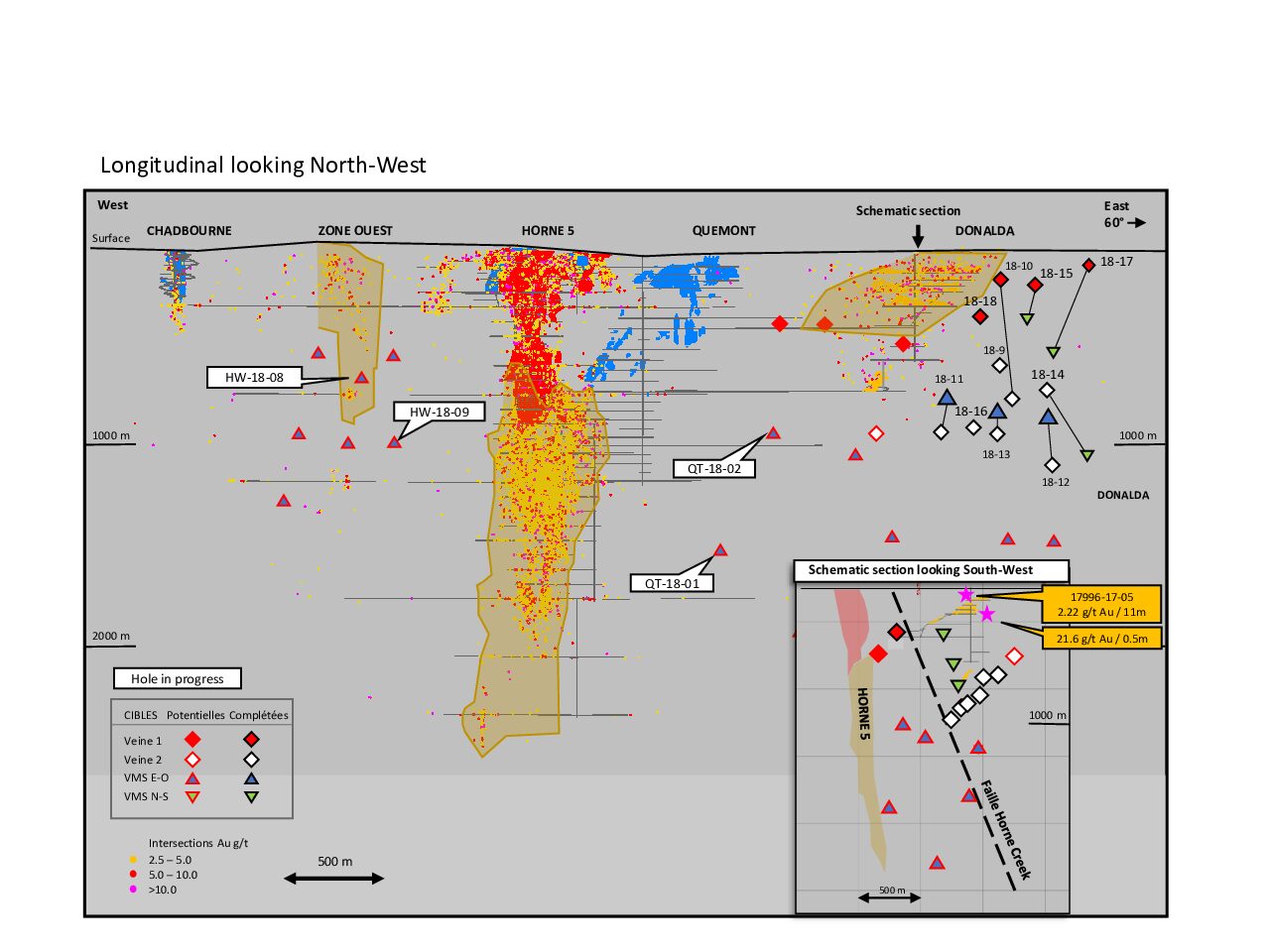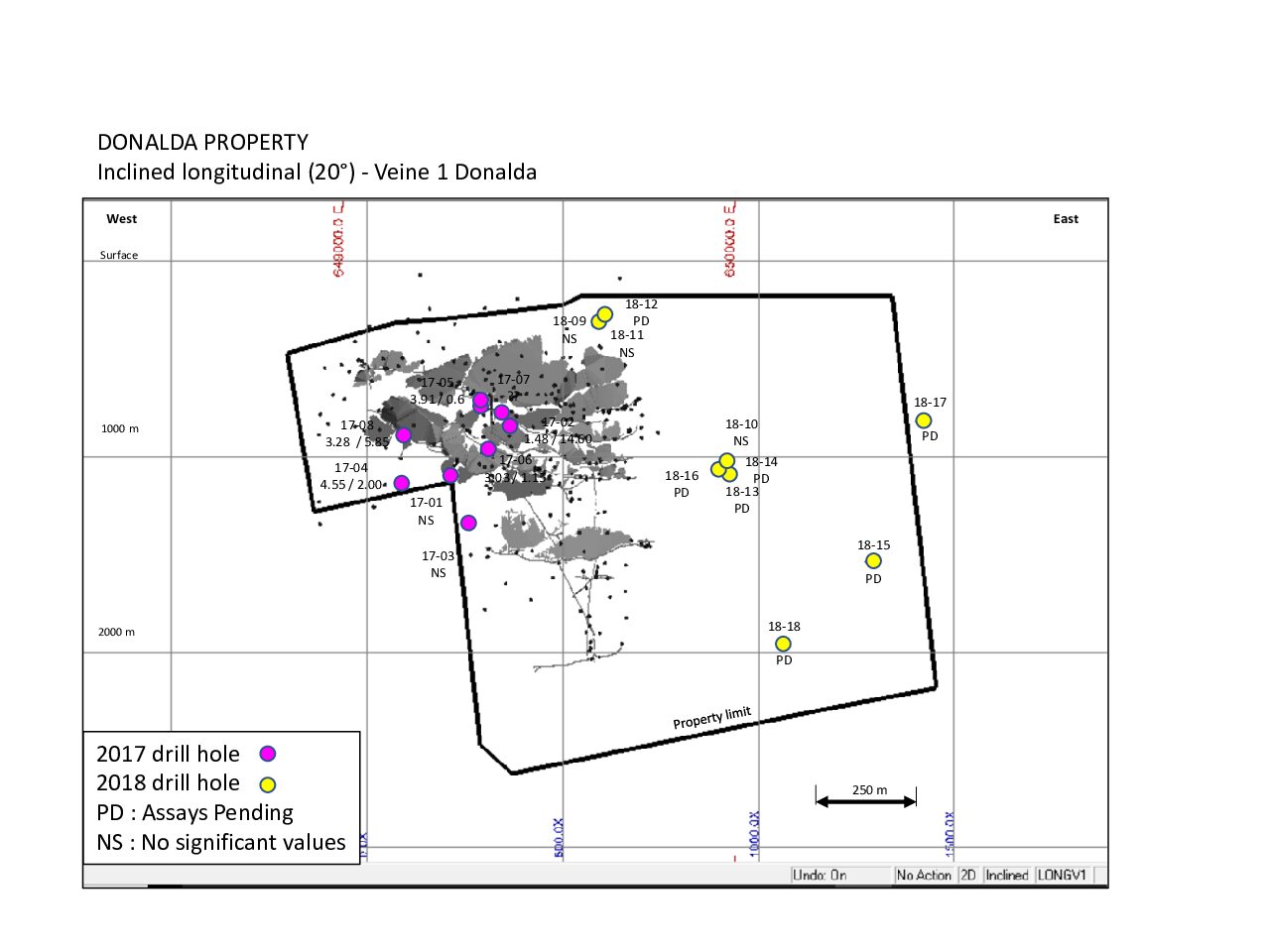Donalda Mine
Location, Access, Description
The Donalda project consists of 7 mining claims totaling 146 hectares in Rouyn Township, within the town of Rouyn-Noranda, Quebec, east of the Horne smelter.
The property is owned 100% by Falco Resources Ltd. subject to a 2.5% Gross Metal Royalty payable to Globex.
Geology and Mineralization
The main geological units of importance on the property are the Quemont rhyolite and the Wilco andesite located in the Donalda mine area. These rocks are cut by the Eldona olivine diabase across the entire property striking N50˿E to N70˿E and dipping sub-vertically.
The Donalda area is cut by the Horne Creek (HCF), Central, Powell and Donalda faults. The Horne Creek Fault is by far the most important in the sector. It marks the contact between the Quemont Rhyolite and Wilco Andesite and slightly offsets the Donalda No. 1 vein.
Gold mineralization is restricted to two narrow but very extensive and continuous quartz veins referred to as the No. 1 and No. 2 veins. The No. 1 vein is hosted by the Quemont rhyolite to the north of the HCF and by the Wilco andesite to the south. The No. 1 vein is also cross-cut and dilated by the Eldona diabase. The No. 2 vein is restricted to the Quemont rhyolite. Grades of 30 to 60 gpt Au are common in these veins and the property hosted a historical (non 43-101 compliant) resource of 1.5M t grading 6.9 gpt Au of which approximately 790,000 t were mined with approximately 710,000 t remain unexploited. The resources were prepared prior to the development of National Instrument 43-101. They are considered historic resources and should not be relied upon.
The No. 1 vein is typically 0.3 m to 0.5 m thick and consists essentially of greyish banded quartz with minor amounts of sulphides, tellurides and native gold. The sulphide content of the vein is generally less than 3%. Visible gold is common, but individual grains rarely exceed 2 mm (ref. Riverin, Bernard and Boily, 1990). Generally the gold is equally distributed between quartz and pyrite, except in the lower part of the vein where there is only a very minor association with pyrite. The gold is restricted to the vein material except in the upper part of the vein where it is also found in the host rock.
The No. 1 vein is a “stepped” vein consisting of segments with alternating shallow dips. Both vein structures are open down dip so the opportunity exists to increase the resource.
The property is host to two important, high grade, extensive and continuous gold bearing structures. It also hosts a considerable (non NI 43-101) historical resource of 1.5M t grading 6.9 gpt Au of which 710,000 t are unexploited. Both those structures could have significant exploration upside seeing as they are open down dip and no exploration has been carried out below the 700 m level. In addition, the property benefits from unique access and proximity to infrastructure including the Horne smelter and mill.
History
The following sections are largely taken from a paper, The Donalda Gold Deposit, Rouyn-Noranda, Quebec by Riverin, Bernard and Boily (1990)
Exploration on the Donalda property dates back to the early days of the Noranda mining camp when the Horne deposit was discovered in 1921. The first substantial diamond drilling campaign in the Donalda area, about 2 km east of the Horne deposit, was carried out in 1943. The discovery hole was drilled by Donalda Copper Mines to test a magnetic anomaly and intersected a spectacular 40 m of core grading 6 gpt Au. Follow-up work on the deposit led to the sinking of a mine shaft in 1946 to explore the deposit and the mine reached production in 1948.
A 620 metre shaft provides acces to the two known gold bearing vein structures. In addition, below the 700 metre depth, very little exploration has been undertaken. Mine production at Donalda totaled 738,787 t ore grading 5.2 gpt Au. Most of the ore was extracted from the shallowly dipping No 1 Vein between 1948 and 1955. During that period, the No 2 Vein was discovered about 300 m below the No 1 Vein. This new vein was mined in 1969-70 from the adjacent Quemont mine workings and 29,156 t of ore were extracted.
The Donalda No 1 Vein was mined out along a strike length of about 825 m and over a dip length of 400 m. It was known by previous operators to persist down-dip at least as far as the Horne Creek fault, but was thought to end at the fault. However, surface diamond drilling carried out by Minnova Inc. in September 1986 located the extension of the No 1 Vein south of the Horne Creek fault. An underground exploration program was initiated in the fall of 1987 and a new southern section of the vein measuring approximately 425 m by 300 m was delineated by underground drifting and raising. This down-dip extension from the old workings is similar in character to the mined-out No. 1 Vein, the only significant difference being that the host rocks consist of magnetic basalts and diorities in the south extension in contrast to rhyolites in the mined-out portion
In 2009, Globex completed a ground magnetometer survey that outlined two anomalously high magnetic structures.
In 2011, Globex drilled 3 holes totaling 417 m on the property. Holes DON-11-01, 11-02 et 11-03 tested a strike length of 130 m along the gold bearing “271” structure. Drilling was located 200 m east of the underground workings of the historic Donalda Mine. The three holes intercepted quartz-feldspar porphyritic rhyolite. The rhyolite was weakly mineralized, containing 1 – 2% pyrite in quartz-carbonate veinlets with centimetres-wide silica and carbonate alteration haloes. The holes encountered narrow widths of gold mineralization including; 0.90 gpt Au over 1.49 m in hole DON-01; 2.78 gpt Au over 1.5 m in hole DON-11-02 and; 2.61 gpt Au over 0.3 m in hole DON-11-03.





